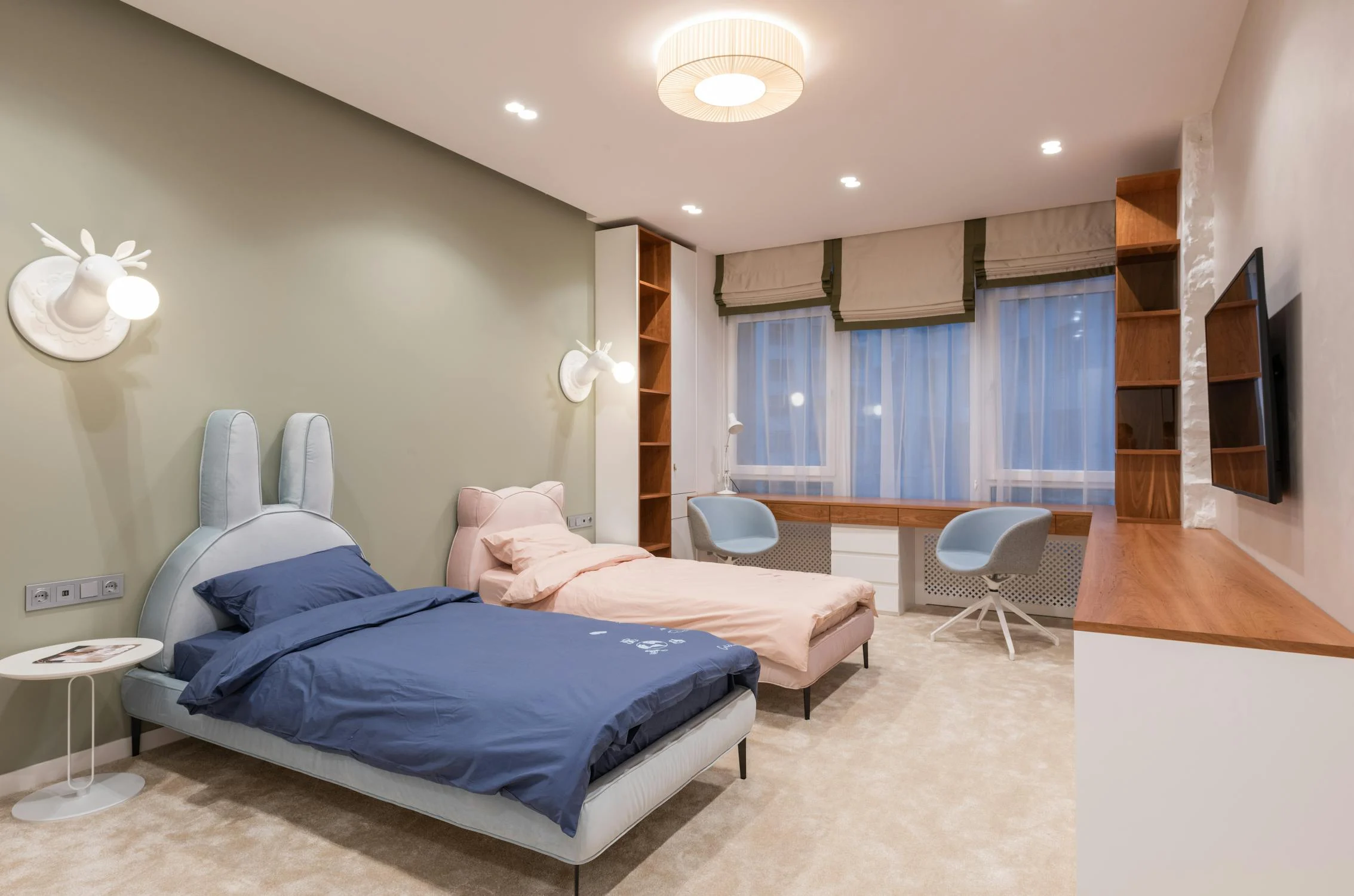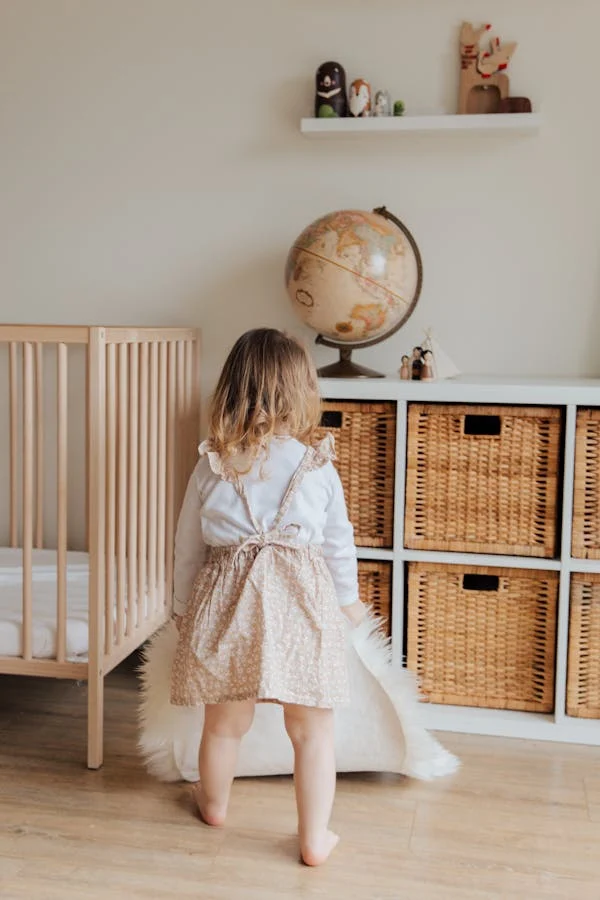
Designing a child’s room is both an exciting and challenging task. The space needs to be functional, safe, and adaptable to your child’s growing needs. Moreover, it should stimulate their imagination and provide a comfortable environment for sleep, study, and play. In this guide, we will explore the essential aspects of children’s room interior design, offering practical tips and creative ideas to help you create a perfect sanctuary for your little ones.
Table of Contents
ToggleUnderstanding the Basics of Children's Room Interior Design
Before diving into specific design ideas, it’s important to understand the fundamentals of children’s room interior design. This involves considering factors such as safety, functionality, flexibility, and aesthetics.
Safety First
Safety is paramount in a child’s room. Ensure that all furniture is stable and free from sharp edges. Secure heavy items like bookshelves to the wall to prevent tipping. Opt for non-toxic paints and materials, and make sure electrical outlets are covered.
Functionality
A child’s room needs to serve multiple functions: a place to sleep, play, study, and store belongings. Dividing the room into distinct zones can help achieve this. For example, designate one corner for a study desk, another for a play area, and ensure there is ample storage to keep the room tidy.
Flexibility
Children grow quickly, and their needs change just as fast. Choose furniture that can adapt to their growth. For example, a bed that can be extended as they get older or modular storage that can be reconfigured.
Aesthetics
While functionality and safety are crucial, the room should also be visually appealing. Use colors, themes, and decorations that reflect your child’s personality and interests. Involve them in the design process to make the room truly their own.

Choosing the Right Color Palette
Colors play a significant role in setting the mood of a room. For children’s rooms, consider both the psychological effects of colors and your child’s preferences.
Popular Color Schemes
– Pastels: Soft shades of pink, blue, green, and yellow are calming and perfect for a serene environment.
– Bright and Bold: For a more energetic and stimulating space, use vibrant colors like red, orange, and bright green.
– Neutral Base with Pops of Color: A neutral base like white or gray with colorful accents can be easily updated as your child’s tastes change.
Thematic Color Palettes
Incorporating a theme can make choosing a color palette easier. For instance, an underwater theme might feature blues and greens, while a jungle theme could use shades of green, brown, and yellow.
Furniture Selection and Placement
Choosing the right furniture is crucial in children’s room interior design. Here are some tips to ensure the furniture is both functional and stylish.
Essential Furniture Pieces
– Bed: Depending on the child’s age, options range from cribs and toddler beds to bunk beds and loft beds.



– Storage Solutions: Invest in versatile storage options like bookshelves, toy chests, and wardrobes to keep the room organized.
– Study Area: A desk and chair at the appropriate height encourage good posture and focus during homework time.

Smart Placement Tips
– Accessibility: Place frequently used items within easy reach of your child to promote independence.
– Open Space: Ensure there is enough open space for play. Avoid cluttering the room with too much furniture.
– Safety: Keep heavy or potentially dangerous items away from areas where the child might climb or play.
Incorporating Storage Solutions


Effective storage is key to maintaining a tidy and functional children’s room. Here are some creative storage ideas:
Built-In Storage
Built-in shelves and cabinets maximize space and can be customized to fit the room’s dimensions perfectly. Consider under-bed storage or built-in benches with storage underneath.
Multi-Functional Furniture
Furniture that serves multiple purposes can save space and add functionality. For example, a bed with drawers underneath or a desk with shelving above.
Creative Storage Ideas
– Toy Bins: Colorful bins and baskets can store toys and make tidying up fun.
– Pegboards: Versatile and customizable, pegboards can hold a variety of items from craft supplies to small toys.
– Wall Hooks and Racks: Use wall space for hanging coats, bags, and hats.
Designing a Study Area
A dedicated study area helps children focus on their homework and develop good study habits. Here are some tips for creating an effective study space:

Ergonomic Furniture
Choose a desk and chair that are the right height for your child. The chair should provide good back support, and the desk should have enough space for books, a computer, and other study materials.
Adequate Lighting
Good lighting is essential for a study area. Natural light is best, so place the desk near a window if possible. Supplement with a desk lamp that provides focused light.
Minimal Distractions
Keep the study area free from distractions. This means minimizing clutter and keeping toys and other non-study items out of the area.
Creating a Cozy Sleeping Area
A comfortable and cozy sleeping area is essential for your child’s well-being. Here are some ideas to make the sleeping area inviting:
Comfortable Bedding
Invest in high-quality, comfortable bedding. Let your child choose the colors and patterns to make their bed a place they love.

Night Lights
A soft night light can help children feel secure and ease the transition to bedtime.
Canopies and Tents
A canopy over the bed or a small tent in the corner can create a cozy, private space where children can read or relax.
Designing a Fun Play Area
A well-designed play area can stimulate creativity and provide hours of entertainment. Here are some ideas to consider:



Soft Flooring
Use rugs or mats to create a soft, safe play surface. This is especially important for younger children who spend a lot of time on the floor.
Activity Zones
Designate specific areas for different activities. For example, a corner with a small table for arts and crafts, another for building blocks, and a space for reading.
Displaying Artwork
Encourage your child’s creativity by displaying their artwork. Use frames, clipboards, or a wire with clips to create a rotating gallery.
Personalizing the Room with Décor
Personal touches make a room feel special and unique. Here are some ways to personalize your child’s room:
Wall Art and Decals
Wall art and decals are an easy way to add personality to a room. Choose designs that reflect your child’s interests, such as animals, superheroes, or nature scenes.
Custom Name Signs
A custom name sign adds a personal touch and can be a beautiful piece of décor.
DIY Projects
Involve your child in DIY projects to create unique decorations. This could be painting a mural, crafting wall hangings, or making their own pillows.
Considering Future Changes
Children’s tastes and needs change quickly, so it’s important to plan for the future. Here are some tips to ensure the room can grow with your child:
Neutral Base
Using neutral colors for the walls and major furniture pieces makes it easier to update the room with new accessories and decorations as your child’s preferences change.
Modular Furniture
Modular furniture can be reconfigured or expanded as needed. This is particularly useful for storage solutions and study areas.
Convertible Furniture
Consider furniture that can grow with your child, such as a crib that converts to a toddler bed, or a desk that can be adjusted in height.
Conclusion:
Designing a children’s room interior is a rewarding project that combines practicality with creativity. By focusing on safety, functionality, and aesthetics, you can create a space that is both beautiful and adaptable to your child’s evolving needs. Remember to involve your child in the design process to make the room truly special and reflective of their personality. With thoughtful planning and a touch of imagination, you can create a children’s room interior design that is both delightful and functional.
Creating the perfect children’s room interior design is an ongoing process. As your child grows, their needs and tastes will change. By incorporating flexible and adaptable elements into the design, you can ensure that the room remains a cherished space for years to come.
If you enjoyed this article, share it with your friends and colleagues! Thank you for helping spread the word!
- you might be interested in reading this post as well
- The Ultimate Guide to Choosing the Perfect Floor Lamp for Your Home


Pingback: Elevate Your Home with Luxury Kitchen Interior Design - ZF Design And Decor